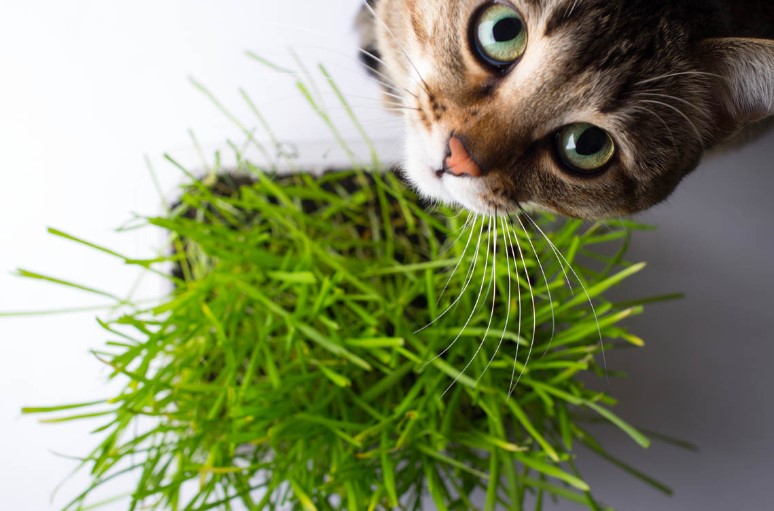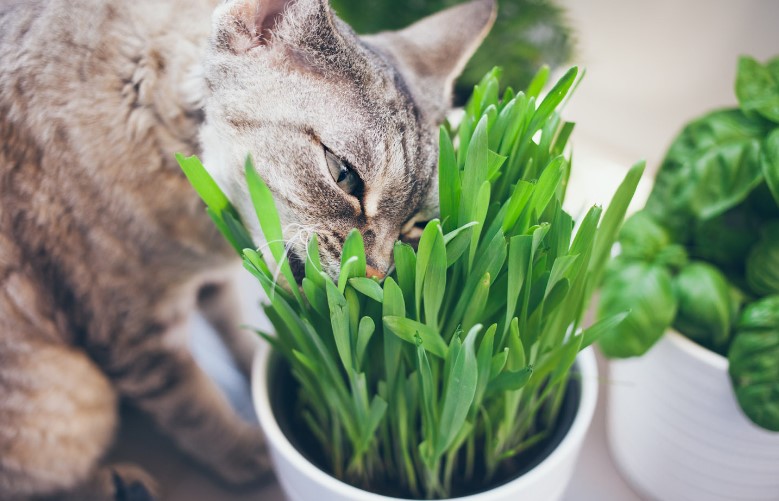There are several different types of cat grass that you can feed your feline friend. Here, you will find information about Barley cat grass, oat cat grass, and Wheatgrass. All of these types are good for your feline friend, but which one is right for your cat? We’ve provided information for you to make an informed decision. We hope you enjoy this information. Just remember that there are pros and cons to each.
Cat grass is different from your usual pet grass. It’s made from cereal grasses and is not only great for your pets but people as well. Drinking cat grass prevents hairballs and promotes healthy bones, teeth and gums in felines. The nutritious grass also does not breed any harmful or fatal parasites.

Types of Cat Grass
There are various types of cat grass available for your cat. Barley grass, for example, is a healthy option that is good for your cat because it is high in amino acids, vitamins, and minerals. Barley grass is also known for its natural flavours. However, you must take into account some factors before giving your cat a grass to nibble. These considerations include size of the container, temperature, watering, and sunlight.
Wheatgrass is an excellent source of dietary fiber. It is low in carbohydrates, high in amino acids and is more resilient. Wheatgrass is also an excellent source of vitamins and minerals. It also acts as a safe fibrous snack for your cat. Wheatgrass is also considered a natural laxative, although it can be a vomiting- inducer. There are also many health benefits of wheatgrass for cats. But whether or not you choose to give your cat grass is entirely up to you.
Barley cat grass
The benefits of feeding barley cat grass to your cat are numerous. It contains active enzymes, beta- carotene, protein, amino acids, chlorophyll, and essential trace minerals, including iron and vitamin B. It can improve your cat’s health by enhancing digestion, and its regular application can eliminate bad breath and boost energy. Among the other benefits of barley cat grass are its antibacterial and antifungal properties. Moreover, it prevents hairballs.
It is easy to grow and contains high levels of vitamins and minerals. Barley cat grass grows up to 14 inches and is a very durable houseplant. It is one of the best choices for indoor cats and can help make your cat healthier and more comfortable. The term “cool cat” dates back to the 1920s and refers to a person who is up-to- date with current fashions. Similarly, cats prefer particular textures in their diets. While rice is fine in small portions, other grains may be better for your cat. Smaller pieces are easier to digest and provide more nutritional value.
oat cat grass
Oat cat grass has become popular for several reasons. It is a natural product, is high in soluble fiber, and has a mildly sweet taste. It helps with digestion, and is especially good for cats with sensitive stomachs. It is also one of the best sources of protein. It is a great alternative to commercial cat food, as it can be inexpensive and easy to maintain. Listed below are some of the benefits of oat cat grass.
Oat cat grass is a self-growing plant. It germinates very quickly, and your cat will
start playing with it as soon as it starts sprouting. If your cat doesn’t go outside, this product is ideal for him. Please note that the price may differ from the advertised price due to errors and situations outside of our control. Oat cat grass is an excellent option for indoor cats who don’t get enough exercise outdoors.
Wheatgrass
Wheatgrass is rich in chlorophyll, also known as liquid sunlight, which is the life force of plants. It boosts the immune system, helps the body eliminate toxins and slows the aging process of cats. Wheatgrass has up to 70 percent chlorophyll, which neutralizes free radicals that are linked to aging. It is one of the most effective natural remedies for cats. Wheatgrass is also gluten-free and organic.
Some cats are even eating wheatgrass every day! According to a New York Times article, it’s becoming more common for cat owners to grow wheatgrass just for their pets. Some cats even use it as a litter box! Cat Country organic wheatgrass litter contains wheatgrass fibers, which are effective at controlling odors. The litter is also perfume -, chemical and polymer- free. But wheatgrass isn’t safe for all cats. Make sure to consult your veterinarian before introducing it to your cat.

Orchard grass
A common species of grass, Dactylis glomerata, is also known as cat grass, cock’s-foot, orchard grass, or cock’s wattle. It is a cool- season perennial C3 bunchgrass native to temperate Asia, Europe, and northern Africa. Despite its common names, it is not always easy to distinguish between them. Here, you’ll learn how to tell them apart.
First, don’t confuse orchard grass with ordinary turf. Cats cannot digest plant matter like rabbits do. Their digestive systems do not contain the enzymes necessary for gaining nutrition from plants. Moreover, hay is generally used for feeding livestock, such as horses, and can be moldy. Worse, wet beds may pose a health risk, especially in the winter months. For this reason, it is better to use cat grass.
Cat grass is a hydrating and tasty treat for your feline friend. Cat Grass offers nutrition that your cat’s body craves. Cat Grass can be fully grown in about 14 days, and will last for several weeks. You can use it to make a houseplant or grow one in the ground in pots or planters.
